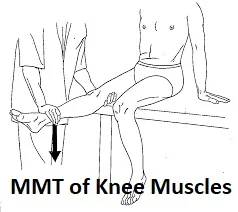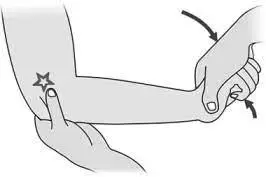Anterior Drawer Test of the Knee
Table of Contents
What is the Anterior Drawer Test?
The Anterior Drawer Test is a fundamental orthopedic assessment technique used to evaluate the integrity of the anterior cruciate ligament (ACL) in the knee joint. The ACL is one of the major ligaments that stabilizes the knee and prevents excessive forward movement of the tibia (shinbone) in relation to the femur (thighbone).
This test is commonly employed by healthcare professionals, such as orthopedic surgeons, physical therapists, and sports medicine practitioners, to diagnose ACL injuries, particularly in cases of trauma or sports-related incidents.
It can be used in junction with the Lachman test, pivot shift test, and MR.
What is an Anterior Cruciate Ligament?
The anterior cruciate ligament is part of the connective tissue inside the knee joint at the front of the knee. The cruciate ligaments cross in an X shape on the front and back. They help control the back-and-forth movement of the knee. The ACL helps keep your knee joint stable.
This ligament can tear during activity or sport. When it happens, it is called a twist. Along with this sprain, other injuries often occur. Other parts of the knee that can be affected are the meniscus, cartilage, and other ligaments.
These tears are usually classified according to severity.
1st-degree sprain: This type of sprain involves minor ligament damage. The ligament is stretched, but it can still keep the joint stable.
2-degree sprain: This twist causes a partial tear. The ligament has been tightened and the joint is now open.
3rd-degree sprain: This type of twist causes a complete tear. The ligament is torn in half and the joint is unstable. Most ACL injuries are complete tears.
Tears or sprains can occur during any activity that requires:
- Suddenly stopped
- Change direction quickly
- Jump in the wrong direction
- Slow down when running
- Do a knee sit-down
Most often, this type of knee injury occurs during turns and landings. The twisting and landing force causes the ligament to tear.? ACL injuries seem to occur more often in women. This may be because women’s joints are looser and they have less muscle mass. It could also be because estrogen relaxes muscles and ligaments, but more research is needed to be sure.
If you’ve injured your ACL, you may experience a variety of symptoms, including:
- A popping sound when landing or turning incorrectly
- Your knee will pull out from under you
- Swelling within 24 hours
- Knee pain
- Pain when walking
- Problems moving the knee or leg
Purpose
Anterior drawer test to check the integrity of the anterior cruciate ligament (ACL).
Technique
The patient lies supine on the plinth, hips flexed 45 degrees, knees bent 90 degrees, and feet against the plinth. The examiner sits on the toes of the limb being tested to help stabilize it. The examiner grasps the proximal tibia just below the tibial plateau or tibiofemoral joint line and attempts to rotate the anterior tibia. The test is considered positive if there is no end sensation or excessive forward translation relative to the contralateral side. Theoretically, anterior translation if less than 6 mm. If it is more than 6 mm, the test is considered positive.
Clinical note
This test must be performed with extreme caution because the starting position can lead to a false positive ACL test result if posterior depression (a sign of a posterior cruciate ligament problem) is missed before starting the test. If there is little or no swelling, the depression is obvious because of the apparent concavity distal to the patella.
If, after performing the anterior drawer test, there is an audible click or palpable jerk when the tibia is pulled forward (Finochietto’s jump sign) and the tibia moves too far forward, it is likely that the glenoid is torn on top of the tibia. . anterior cruciate ligament. ref> Strobel M, Stedtfeld HW. Diagnostic evaluation of the knee joint. Springer Research and Business Media; December 6, 2012.
Evidence
One source reported sensitivity and specificity from 0.41-.91 to 0.86-1.0, -LR was 0.09-0.62 and LR was 5.4-8.2. However, a recent meta-analysis reported a sensitivity and specificity of 0.18-.92 and 0.78-.98, respectively. Scholten et al concluded that the predictive value statistics did not allow strong conclusions about whether the anterior chest test was good for deciding or excluding an ACL tear. Other recent studies have found that the anterior chest test is a more effective test for chronic disease, with a sensitivity and specificity of 0.92 and 0.91, respectively.
ACL laxity or instability of the knee depends on the forces applied to the knee and increases with greater force. They range in clinical trials and moderate to strong activity. Therefore, the anterior compartment test cannot always predict ACL loss or joint instability during strenuous activity. Joint laxity can decrease if a person reduces their activity after an injury. Thus, operational stability can be maintained.
Katz and Fingeroth reported that the anterior knee pull test has a diagnostic accuracy (within 2 weeks of examination) of acute ACL tears: 22.2% sensitivity and >95% specificity. The study reported a diagnostic accuracy of 40.9% sensitivity and 98.4% specificity for subacute/chronic ACL tears (more than 2 weeks prior to the study).
It is important to note that all examinations in this study were performed under anesthesia; Therefore, the diagnostic accuracy of physical therapy clinical practice may be lower. The anterior knee pull test, although widely used, is a diagnostic indicator of ACL tears, particularly in the acute setting.
Summary
The Anterior Drawer Test is part of a comprehensive clinical assessment that aids in formulating an accurate diagnosis and treatment plan for knee injuries, particularly those involving the ACL. It is important to note that this test should be performed by trained professionals to ensure accurate results and to prevent any potential harm or discomfort to the patient.
FAQ
To perform the anterior box test, raise the patient’s hip to 45 degrees and the knee to 90 degrees. You can fix this position by gently sitting on the patient’s leg. Then touch the joint line with your thumbs and try to move the shin forward in an explosive motion.
If the tibia pulls forward or backward more than usual, the test is considered positive. Excessive anterior displacement of the tibia indicates damage to the anterior cruciate ligament, while excessive posterior displacement of the tibia may indicate damage to the posterior cruciate ligament.
The anterior drawer test can be evaluated to reflect the amount of anterior tibial translation. The most frequently used scale is the following: Class 1: 5 mm; class 11: 5-10 mm; Class III: more than 30 mm (22). The scoring is based on the researcher’s subjective assessment of the translation of the tibia.
Your doctor or therapist will use the anterior box test to check for an ACL or ACL injury. This is one of the most common knee injury assessments.



![Test for tight retinacular [ collateral ] ligaments](https://samarpanphysioclinic.com/wp-content/uploads/2023/06/Test-for-tight-retinacular-_-collateral-_-ligaments.webp)


